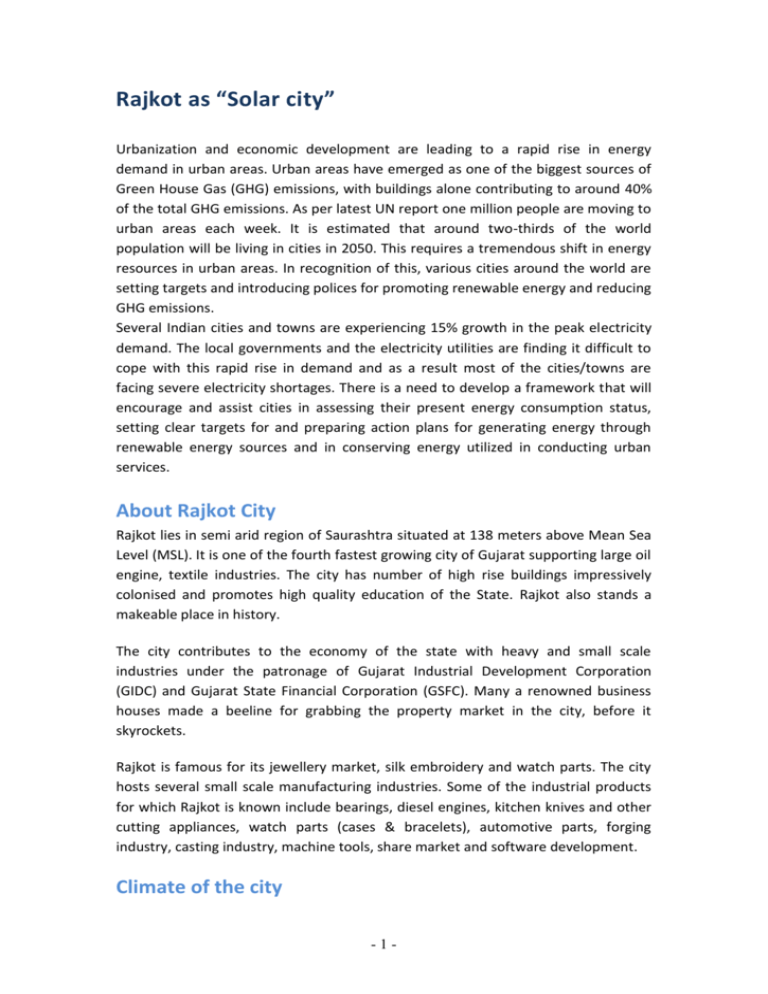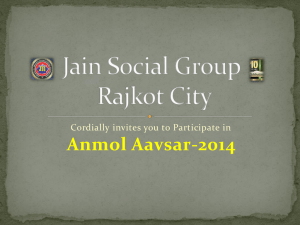Rajkot as “Solar city”_ - carbonn Climate Registry
advertisement

Rajkot as “Solar city” Urbanization and economic development are leading to a rapid rise in energy demand in urban areas. Urban areas have emerged as one of the biggest sources of Green House Gas (GHG) emissions, with buildings alone contributing to around 40% of the total GHG emissions. As per latest UN report one million people are moving to urban areas each week. It is estimated that around two-thirds of the world population will be living in cities in 2050. This requires a tremendous shift in energy resources in urban areas. In recognition of this, various cities around the world are setting targets and introducing polices for promoting renewable energy and reducing GHG emissions. Several Indian cities and towns are experiencing 15% growth in the peak electricity demand. The local governments and the electricity utilities are finding it difficult to cope with this rapid rise in demand and as a result most of the cities/towns are facing severe electricity shortages. There is a need to develop a framework that will encourage and assist cities in assessing their present energy consumption status, setting clear targets for and preparing action plans for generating energy through renewable energy sources and in conserving energy utilized in conducting urban services. About Rajkot City Rajkot lies in semi arid region of Saurashtra situated at 138 meters above Mean Sea Level (MSL). It is one of the fourth fastest growing city of Gujarat supporting large oil engine, textile industries. The city has number of high rise buildings impressively colonised and promotes high quality education of the State. Rajkot also stands a makeable place in history. The city contributes to the economy of the state with heavy and small scale industries under the patronage of Gujarat Industrial Development Corporation (GIDC) and Gujarat State Financial Corporation (GSFC). Many a renowned business houses made a beeline for grabbing the property market in the city, before it skyrockets. Rajkot is famous for its jewellery market, silk embroidery and watch parts. The city hosts several small scale manufacturing industries. Some of the industrial products for which Rajkot is known include bearings, diesel engines, kitchen knives and other cutting appliances, watch parts (cases & bracelets), automotive parts, forging industry, casting industry, machine tools, share market and software development. Climate of the city -1- Rajkot has a semiarid climate, with hot,dry summers from mid-march to mid-june and the wet monsoon season from mid-june to October, when the city receives 500mm of rain on average. The months from November to February are mild, the average temperature being around 20oC, with low humidity. During summer time, the temperature ranges between 24oC and 42oC. In the months of winter, Rajkot temperature varies between 10oC and 22oC but on a whole winters are pleasant. Energy Conservation Programs by RMC 1. Asia Pro-Eco Program Rajkot Municipal Corporation has successfully participated in Asia Pro Eco Programme of “European Commission” during 2004-2005 along with Leicester city of UK and Gaia city of Portugal. The project had focused on “Partnership Support for Renewable Energy between European and Asian Towns”. 2. Energy Park at Rajkot Identifying the work done by Rajkot Municipal Corporation in the field of non conventional energy sources, Ministry of New and Renewable Energy provided grant for construction of “District Level Energy Park” at Rajkot. Constructed in April 2007. It is a Permanent Exhibition of appliances based on Non-Conventional Energy Sources Information Center for Documentation and Dissemination of Renewable energy Energy education / communication for Publications, Films & audio – visual Aids, Exhibitions and demonstrations, Awareness Programs – Workshop & Seminars Capacity building Center Training Center to ensure Energy Efficient Operation, Maintenance and Management of RE Resources To create an Energy Literate Citizen of making wide Energy Choices Promotion of use of RE thro Private Sector & Community Participation Fostering Energy Literacy Public private participation for installation of solar streetlights and traffic blinkers Applied to MNES for grant in aid for capacity building of technical fraternity on renewable energy regulation compliance Information Centre for renewable energy promotion -2- Drive for compliance of building regulations 3. Building Bye-lawsa) Solar assisted water heating system: Rajkot Urban Development Authority has revised its Building Bye Laws-General Development Control Regulations act (GDCR) in 2004 and included a clause for mandatory provision of “Solar Assisted water heating System”: Clause No 17.22, Page No 101/102: “ New Building in the following categories in which there is a system or installation to supplying hot water shall be built unless the system or installation is also having an auxiliary solar assisted water heating system : a) Hospitals and Nursing Homes b) Hotels, Lodges and Guests Houses c) Hostels of Schools, Colleges , Training Centers d) Barracks of armed forces, paramilitary forces and police e) Individual residential buildings having more that 150 Sq mt plinth area. f) Functional Buildings of Railway station and Airport like waiting rooms , retiring rooms, rest rooms, inspection bunglows and catering units g) Community Centers, Banquet Halls, Barat Ghars, Kalyan mandaps and buildings for similar use. In last 3-4 years, people have realised and started using Solar water heating system and also technical fraternity of Municipal Corporation have been taking care of strict compliance of above mentioned building bye law. Following observations are noticed 1. In Rajkot city, the no of total Solar water heating systems installed so far is @ 16,000 no. as per information collected from the dealers of Solar water heaters in Rajkot. 2. The amount of electricity saved per year is approx. @ 5,76,000 kwh. 3. If we calculate an amount in terms of Rs. For 5,76,000 units of electricity (assuming rate of electricity @ 6 Rs per kwh) Rs. 34,56000/4. Rajkot Municipal Corporation has installed 10kwp system “Solar Grid connect system” at the cost of Rs 26 Lacs. Since February 2010, it has been working successfully, generating average of @ 48 units (kwh) every day. It accounts for approx. @ 6720 kwh until June 26th from February 2’2010. If we calculate -3- the amount saved, it comes out to be about Rs 41,000/-. It means saving of approx. @ Rs 8000/- per month. 5. Installation of 180 Solar-LED street lights in various parts of the city is in progress, 55 already installed. 6. Administrative procedure for procurement of Solar Grid Connect 100 kwp system, one for each of east and central zonal offices is in progress. 4. Recycling and reuse of waste water: It is estimated that, around 45 % of used water can be reused if proper care is taken for recycling it. Scientific technologies and methods are available and are easily applicable without much maintenance. Considering all this as Rajkot has been facing severe water crisis for last many years, Rajkot Municipal Corporation has recently passed resolution for “Recycling and reuse of waste water” in new developments coming up in the city and the use of potable domestic water for non potable uses like car washing, gardening, construction purposes, landscaping, irrigation uses is for bidden by virtue of powers vested with government. 5. Harvesting of rooftop rain water: Since March 2004, rooftop rain water harvesting has been made mandatory through GDCR. It has brought remarkable rise in the ground water level. It is estimated that, since March 2004, more than 25000 households have adopted the system of rooftop rainwater harvesting, and have helped in recharging the ground water. Solar city programme The government of India has planned to develop 60 cities into ‘solar city’ during the 11th Five Year Plan (2007-12), to both meet the increasing electricity demand of its cities and promote the growing use of renewable energies. 300 million Indian Rupees (INR) (€6million) are expected to be spent during the 11 th Plan period, under a programme called “Development of Solar Cities”. The amount will be taken from the allocated budget for solar thermal energy programmes under the MNRE's demands for grants. An indicative target of 60 cities/towns with atleast one in each State has been set for the 11th Plan period. Rajkot is one of the selected cities to initiate in for the solar city under the programme. Rajkot Municipal Corporation has planned to set up 200 kilowatt-peak (kWp) solar grid connect photovaltic(PV) system power station within the next six months. The -4- system will be implemented in phases initially, a 100kWp system in the city’s west zone following by the second half in next phase. The investment on the plan is estimated to be Rs.2.50 crore for setting up the solar grid system. REABATE IN PROPERTY TAX: On June 25’ 2010, Standing Committee and The General Board of Rajkot Municipal Corporation have passed resolution to provide rebate in property tax for the user of Solar assisted water heating system. It is decided that_ a. For the residential units, using solar water heating system a rebate of Rs 500/- per year for five years b. For the commercial units, using solar water heating system a rebate of Rs 1,000/- per year for five years ESTABLISHMENT OF “ SOLAR CITY CELL”: Rajkot Municipal Corporation has already sent a proposal to GEDA and MNRE for establishment of Solar City Cell. Reply is awaited from GEDA and MNRE. ENERGY EFFICIENCY IN STREET LIGHTING: Rajkot Municipal Corporation has received proposal on “swiss challenge mode” for energy efficiency for street lighting on BOT base. It has guaranteed for 30 % of energy savings in street lighting. This proposal is under consideration. NATIONAL LEVEL WORKSHOP AT RAJKOT: Rajkot Municipal Corporation has planned from National level workshop in the month of November this year. The intimation is already sent to GUDM and GUDC. A special cell is established to look after the formalities for design of the workshop. It has been planned to involve MNRE, GEDA, ICLEI, GUDC and all other related agencies and also to invite other solar cities across the country. Once the dates are decided, all agencies will be informed and invited for their participation. -5-





